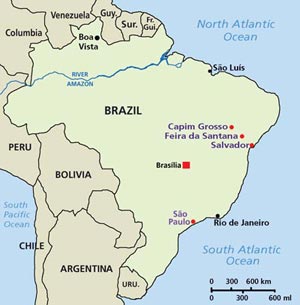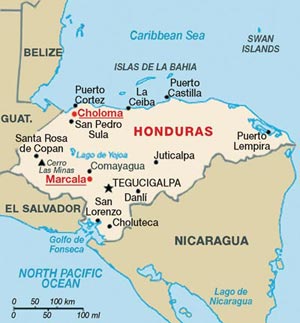|
Founded
in 1937, the Medical Missionaries of Mary is composed
of some four hundred women representing nineteen different
nationalities. The work of the sisters in fourteen countries
is co-ordinated from the Congregational Centre in Dublin,
Ireland. Medical Missionaries of Mary are committed to
healing and development in a way that is locally appropriate
and cost-effective. Sisters can be found at five locations
in Brazil and two in Honduras where they do valuable work
among poor and marginalised people.
|

Marie Martin in Ballgown |
Marie Helena Martin was born in Glenageary, County Dublin, on 25 April 1892. During the Great War of 1914-1918, she served as a volunteer nurse in Malta, France and England. It was at this time that she saw the world’s need for healing and began to think of devoting her life to bringing comfort and health to others. In 1921 she sailed for Nigeria. She lived close to the people at Calabar in the south-east of the country. Travelling up country with local companions, she saw the extent of people’s suffering from ill-health, and had special concern for mothers and their young infants. She felt that alone she could do little. But if she could establish a group of women who would commit themselves to this work, the situation could be changed. She returned to Ireland with a view to recruiting others who would return with her to Africa.
For many years Marie Martin was dogged by ill-health and other obstacles. Eventually, by 1934 she was well enough and had found some pioneering companions willing to form with her the nucleus of a religious missionary group trained with the skills to bring healthcare where there was none. But at that time the Catholic Church would not permit women in religious life to engage in obstetrics and surgery, both of which were central to her vision of serving the peoples of the Southern Hemisphere. It took further patience as she made her vision known and waited for the rules to be changed.
Then in 1936, the way was cleared. She and her first companions sailed for Nigeria in December that year. The necessary protocols to establish a new religious Congregation were being processed in Rome. However, once again, illness was to strike Marie Martin. She was taken to Port Harcourt Government hospital, suffering from a very serious form of malaria. There were fears for her life and it was there, on 4 April 1937, that she made her Profession of Vows and became known as Mother Mary Martin. As soon as she was able to travel, she was booked to sail back to Europe, leaving her pioneering companions behind. Her doctor shook his head as she left the hospital, saying, ‘Let me never see that woman back in Africa!’
From that fragile and slender shoot, the Medical Missionaries of Mary began to grow, expanding to become a group of more than four hundred women of nineteen different nationalities, working today in eleven southern-hemisphere countries with support activities in the USA, UK and Ireland.
The
Medical Missionaries of Mary in Brazil
In the early 1960s Pope John XXIII made an urgent appeal to missionaries to help local churches in Latin America. Mother Mary had always hoped to help with the opening of a mission in Latin America. The civil war in Nigeria (1966-1970) caused doubt about the future of the Medical Missionaries of Mary in that country and a large number of novices were preparing for their future work. It was decided to open a mission in Brazil.
Following an initial exploratory visit in 1968, on 14 August 1969, Sisters Brigid McDonagh and Sheila Lenehan left for São Paulo and soon began a four-month intensive course at the Intercultural Formation Centre (CENFI) to learn the language, history, culture and politics of this complex country. On completion of the language course, they had to face the task of revalidating their qualifications, Sheila in nursing, and Brigid in pharmacy, which was no small challenge in a new language!
They lived and worked in a shelter for pregnant women who were single and poor, often rejected by their families. Two years later they moved to the northern periphery of the city to a parish run by the Kiltegan missionary priests among the very poor.
In line with the pastoral options of the church, the Medical Missionaries of Mary in Brazil chose to avoid establishing institutions, but rather to help people to improve their health and social wellbeing. They started a clinic in Imirim at São Roque twice a week and another in Lausane Paulista, where the clinic was held in a disused mineral-water plant. They found a place for a clinic in Parque Mandi where the first clinic was held on 24 March 1972. They began visiting the families in the community and started treating the sick. After a while the State gave them vaccines to immunize the children. Clinics were soon established at Ladeira Rosa and Santa Cruz, which at that time belonged to the parish of Maracanã.
When the two pioneers had completed their first three years in Brazil, they were joined by three more Sisters, then eight others in the succeeding years, with more to follow.
During this time urban development and the growth of a more middle-class community was beginning to establish itself around Imirim and Maracana where the Medical Missionaries of Mary had been working for over a decade. As the poor were forced to move further out to the periphery, so also the Medical Missionaries of Mary felt it was time to move to the new periphery communities too.
Sister Protagia Slaa from Tanzania was the first African-born Medical Missionary of Mary to be assigned to Brazil, and was especially welcomed by the numerous Afro-Brazilian people among whom the Medical Missionaries of Mary were working in the
favelas (slums). Sister Bernadette Unamah later arrived in São Paulo from Nigeria.
In Ladeira Rosa, the basic Christian community had no priest in charge when the Medical Missionaries of Mary took over in 1979. As well as pastoral care which was coordinated by Sister Philomena Sheerin, the work involved caring for the hungry, the sick, the abandoned, the evicted, and with appeals from the municipal social workers for the sisters to absorb problems they themselves could not resolve from their resources. By now Sister Sheila Lenehan was covering the health clinics at Parque Mandi, Parque Belem, São Roque, Ladeira Rosa and Peri. At weekends she helped out in the pastoral area. In 1980 Sister Philomena Sheerin was called to be Coordinator of the Sector of Brasilândia where there were thirty basic ecclesial communities, all in socially deprived areas. She became the first woman in Lapa Region to occupy such a position. In October 1980 two Sisters moved to the town known as Colorado in the diocese of Apucarana, in the State of Paraná, about ten hours by bus from São Paulo. At the request of the people of Colorado the Medical Missionaries of Mary assumed responsibility for the supervision of nursing care in one of the town’s two hospitals which served the poorer section of the population. As well as hospital work, the organisation and orientation of community health teams to assume responsibility for the care of the sick in their homes, the wellbeing of the elderly, and especially the education of the population towards preventive medicine, was a priority. In 1986, when Sister Ann White joined the Colorado community, she assumed responsibility for the coordination of a child health project, which had been launched by the church throughout the country, in conjunction with UNICEF.
Meanwhile back in São Paulo, in August 1982 the sisters working in the south-western periphery at Pirajussara moved from their accommodation over the parish centre to a house in Jardim Florida. The work here also centred around clinics, visiting the sick, taking emergencies to hospital, advising the handicapped about how and where they might get essential equipment, consoling the bereaved, Bible circles, youth groups, nursing courses, community pharmacy, parish outings and study days.
|
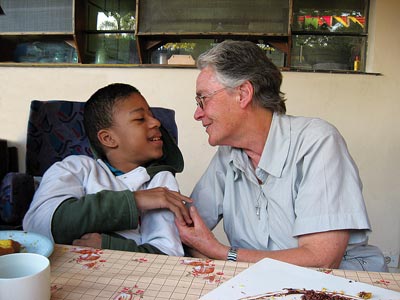
Sister Phyllis Heaney |
Sister Phyllis Heaney has been working in São Paulo since 1975 and is still working in the south-western periphery of the city. Her great gift is with people who have special needs. She is currently the co-ordinator of a centre called ‘Child of Hope’, where there is a great spirit. Four full time staff work with forty children and adults. Most of the mothers of the children are also involved. They are supported by a number of volunteers. Each morning a minibus collects the children and staff, all have breakfast together, then daily activities commence. Every two weeks a psychologist comes to work with the mothers in groups, providing support in coping with their child. Sister Phyllis, accompanied by other staff members, visits the home of each person once every six weeks, helping to address any particular problems they find.
Back in 1981 a new community was established on the northwest periphery of the city in Vila Santa Terezinha, in the neighbourhood known as Brasilândia. A small pharmacy was kept, and Sister Brigid provided advice to people puzzled by the numerous prescriptions they were handed at various health centres. In a nearby neighbourhood called Jardim Princesa a house was purchased for the opening of the Medical Missionaries of Mary Novitiate in Brazil. By now, the work in Colorado was bearing fruit and the first two Brazilian Missionaries, Sisters Cleide and Maria José, were received into the Novitiate on 11 February 1984.
In 1987 the Medical Missionaries of Mary celebrated the Golden Jubilee of their foundation. The community in Brazil, now numbering fifteen, asked themselves some searching questions. It was decided that half the Sisters should withdraw from the area in which they were involved and make themselves available for a new mission in a diocese where they were more urgently needed. Research began and contacts were made.
Later, when the Medical Missionaries of Mary decided to have their two Novitiates located in Africa, the house at Jardim Princesa was sold. The Medical Missionaries of Mary also moved from Vila Terezinha, while Sister Brigid settled among the ecclesial community on a hilltop in nearby Jardim Damasceno where she is still working now.
Move
to Bahia
Developing the work in Bahia meant withdrawing from Ladeira Rosa and Colorado for an area of Brazil where there were enormous stretches that had few or no pastoral or health agents. This move happened in 1988.
It takes a journey of forty-four hours by bus from São Paulo to Salvador, the capital of the State of Bahia. Sisters Eleanor Donovan and Ann White pioneered the new mission at Capim Grosso in the interior of Bahia, some four hours by bus inland from the State Capital. They were later joined by the two Africans, Sisters Protagia and Bernadette. Six years later Sisters Ursula Cott and Maria José founded the Medical Missionaries of Mary community in the city of Salvador. With the arrival of the new millennium, they were joined by Sisters Regina Reinart and Sheila Campbell, which allowed Sister Ursula to establish another mission in the city of Feira da Santana, the second largest city in the State of Bahia.
|
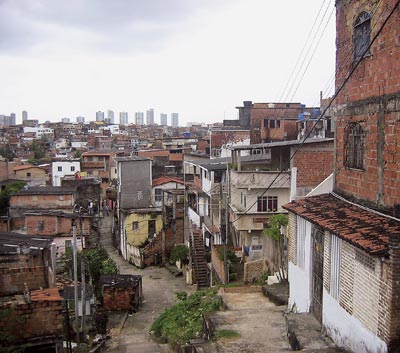
Salvador |
In the city of Salvador, Sister Maria José became increasingly involved with the movement of Afro-Brazilians in addition to her work with women who are helped to improve their self-esteem through art therapy and craft work which can lead to some small income-generating projects.
Sister Sheila Campbell took up work with women from the poorest class of society. Trapped in prostitution by illiteracy and poverty and traumatised by violence since childhood, many of these women suffer from sexually transmitted diseases and violent abuse of their clients or home partners. Sister Regina, from Germany, as well as her training in science and theology, brought special talents for working with young people through music and choreography.
Sister Siobhán Corkery describes what she found when she arrived on mission in the rural area around the town of Capim Grosso:
The eleven million people who inhabit this region in northeast Brazil live in a semi-arid land known as the
sertão with vast backlands of stunted trees and cactus. Although Brazil has eight per cent of the world’s fresh water, Bahia lacks adequate water for its population. The Medical Missionaries of Mary work to mobilise rural communities in the struggle to obtain water. We also help them to secure resources by building cisterns to collect rain water during the short rainy season. This water is one of the few reliable sources of safe drinking water in the area of Capim Grosso.
The system of providing healthcare through the structures of the basic Christian communities was similar here to what had already been done in São Paulo, but in Capim Grosso the arid land and the poverty of the rural communities was very different to the crowded neighbourhoods of the cities. Here poverty ravages family life at every level. Many people, especially children, are malnourished. Illnesses go untreated since people cannot afford transport, much less medicines.
In an area subject to periodic and often tragic drought, the people tend to migrate to the cities which, unfortunately, have a high rate of unemployment. Those who continue to live around Capim Grosso have only small farms which are inadequate even to feed their own families.
|
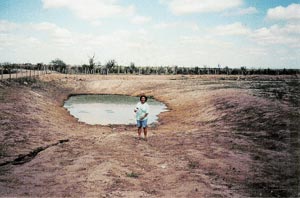
A water hole near Capim Grosso |
The women in these households draw water from great distances. Here small farms are located at a distance from one another and do not have electricity or access to public transport except on a Fair Day. Among the people with whom we work, 79% earn about one euro or one dollar a day. This means that many people, especially children, are malnourished, they have little protein in their diet. Many illnesses go untreated because people cannot afford transport and even if they get to medical facilities they cannot afford to pay for the medicine prescribed. The climate in this semi-arid area is hot and dry with temperatures of 85o F (=29.4 C°) and upwards. Rainfall is unpredictable and shortage of water is always a primary problem. Our parish stretches over a wide area including forty-four basic Christian communities in rural areas and six more located in townships.
During our meetings with the village communities, some of our women could not attend because they had gone with horse and cart a long distance to fetch water. This gave rise to a discussion among us as to how we women could help one another. After many conversations, members of several households told us they would be available to collaborate with any initiative. That is when we began to dream.
We dreamed of having water tanks situated next to everybody’s house. These would collect rain water whenever it rained. Each tank would hold 15,000 litres. That would keep a family in water for cooking and drinking for eight months of the year. That was our dream!
Once we saw clearly what we wanted, we drew up a programme of what would be needed to make the dream come true. Part of that programme was of a very mundane nature - cement and bricks and gutters and pipes. But we knew that more than that would be required if this dream was to be really fruitful. We were not just embarking on the building of water tanks. We were trying to create an appreciation of the great gift of water, its value in our lives, our communal responsibility to protect our water sources, and each person’s human right to have access to clean sources of water.
We missionaries shared our dream with our friends and families and communities back at home. Also with some Donor Agencies who might be interested in funding our dream. We told them we wanted the means to catch the rain water. You could spend a lot of time and money digging around here and not find suitable drinking water.
|

Our dream caught the imagination
of the youth groups |
We also told our friends that we planned to produce a Manual that would serve to raise awareness about the value of water in our lives. This Manual provided the texts for five community encounters on different themes and with appropriate songs, where people could examine and debate the issues related to water supply and water shortage. This also caught the imagination of our Youth Groups, who were encouraged to create dramas depicting the four elements, earth, air, fire and water. They were very creative in their response. Their participation helped older people to grasp what was entailed in working together as a community to secure the water that is essential to life. It made the young people aware of their important role in making this dream come true. The response to our shared dream was incredible - both from our friends and Donor Agencies and from our local communities.
As soon as we had a little money in hard to get started, various Committees were set up at parish and community level. Labourers were hired. First they were trained to make the moulds for the bricks and in the art of bricklaying. This project opened the way for us to become involved in many new communities where we had not worked before. In these we were able to commence discussions around health issues and hygiene. Before long, we found ourselves establishing Health Committees, studying our guidelines, and discussing issues related to the status of women and women’s rights.
In a very short time the first tanks were constructed. Gutters were bought and mounted on the tiled roofs. All we needed was to await the first rains. By the time the rains came many houses were ready. We went to one woman and asked her what the water tank did for her. ‘You ask me what the tank is like?’ she exclaimed. ‘It is like my mother - always there to help me.
The arrival of Sister Jean Eason and later Sister Pauline Connolly strengthened the Medical Missionaries of Mary’s presence in Bahia. The development of work in low-cost remedies from locally-grown plants was extended, as well as home pharmacies. With the water cisterns in place, great effort was put into the provision of latrines in the rural areas. A playschool was also developed into a major project of the community, which enabled young mothers to get some free time from childminding and take up part-time employment.
The
Medical Missionaries of Mary in Honduras
When Hurricane Mitch blew up from the south Atlantic in 1997, it devastated the many countries in its path, especially those of Central America. This prompted the Medical Missionaries of Mary, who had been contemplating an expansion of their work in Mexico, to look to the desperate plight of the people of Honduras. They examined the size of the challenge and began dialogue with local people as to where their skills and resources could best be utilised.
In 1998 the Medical Missionaries of Mary community moved in to the parish of Marcala in the north-western highlands, near the border with El Salvador. Marcala itself has a population of 14,000. The parish is divided into four sectors and stretches over a radius of about fifty kilometres, and the mountainous terrain makes it difficult to access many of the communities. Each sector has its own salaried Health Promoter who works with the Medical Missionaries of Mary, making up the parish Health Team.
The pioneering sisters, Rita Higgins, Mary McKearney and Renee Duignan began to work with the local people on health and nutrition, while a lay volunteer, Mary Egan, took up distance education with the parish radio station, Radio San Miguel. In the rural areas where there are no telephones, no regular means of transport and no electricity, Radio San Miguel is a life line linking people to Marcala, to the rest of Honduras and to the world.
The sisters began working with the local communities in the process of training health promoters and local midwives. This meant providing workshops and training and health monitoring over an extensive rural area. An important aspect of the work is the production of low-cost remedies from local plants, undertaken at the request of the local people who had a rich tradition in local remedies, but feared it was being lost to the younger generation.
By the year 2000, thirty-six Health Committees were established, each with a voluntary Health Promoter who is a liaison person between the heath committee and the health team. Improving health education and healthcare is an important aspect of the integrated Development Plan of the parish, which has been running since the early 1900s. It places great stress on agricultural development, with agricultural advisors helping people to make the most of their knowledge and running a credit union scheme.
By 2003, when the Medical Missionaries of Mary had been five years in Honduras, they had more than one thousand children taking part in the health education programmes that they organise in the four sectors of their parish, at Marcala, Yarula, Nahuaterique and Santa Elena. In the beginning they intended to work only with adults, but soon realised that the children were just as interested in what was being taught. Together with people young and old, the sisters set about focusing on reclaiming the long tradition among the people in the use of natural medicines.
|

Sister Rita Higgins at a Health
Education Workshop in Marcala |
Sister Rita says:
We find the children timid and shy, they lack recognition and stimulation and many live with violence in the home, often due to alcoholism. In the more remote sectors of the parish we bring health education including first aid and complementary therapies, and try to address environmental and gender issues. The focus of our children’s programme is to help them develop their creative and imaginative skills. This helps them build their self-esteem and find their voice. Progress is slow and difficult to measure, yet we marvel each time a little girl struggles to overcome her shyness and tentatively expresses an opinion or participates in an activity. It is the same with adult groups. Though the health issues are important and relevant in themselves, they are also a vehicle through which a woman’s confidence and self-esteem may be nurtured. Though shy and self-conscious in the beginning, once we get discussing the health problems faced by the community, the level of trust increases, experiences are shared and solidarity is fostered.
In 2004 a decision was made to establish a second mission in Honduras, much further north at Choloma. This is an area with 180,000 people, and is one of the areas worst affected by Hurricane Mitch. Since the hurricane major reconstruction of the highway bridge, railroad bridge and flood plains has been undertaken.
The town has a growing population. Many people have migrated to Choloma from other parts of the country to find work in the many factories in the area, and the town has all the problems of a growing urban setting, including a high incidence of HIV infection.
The first workshop given in Choloma consisted of forty-six men and women who came from twenty-one of the twenty-four communities in the large, sprawling parish. Some were well educated, while others had little education, but all desired to help their communities in a spirit of generosity. Some women travelled from mountain communities, leaving at four o’clock in the morning on horseback to reach the foot of the mountain, from where they had to take three buses.
Participants agreed to a year-long programme of workshops to empower them as Health Promoters. These focused on domestic violence, HIV/AIDS, psychology of adolescents, addiction and pastoral care of the sick. Since that first workshop twenty people have become part of a Health Committee and begun projects in their community.
|

On the road in Honduras |
The truck carrying the health team heads out of town at 7am. It will be two hours, at least, before they arrive at the little mountain church under the
ceiba tree. Mass is a real celebration. It is a big day for the community having Fr. Enemecio Del Cid with them. The women prepare a communal lunch, which will be taken outdoors.
But first comes the health education. There are many issues to be worked through by the seventeen health committees around this vast parish. AIDS is one of them. Water-borne diseases another. Lack of water. Lack of a sewerage infrastructure. Domestic violence, including abuse of children.
Sister Renee says:
We do a lot of group work to try to improve self-esteem. We believe this contributes to improved health in the community. We teach people how to do reflexology and massage. People love this. They tell us it helps them to cope with the huge amount of stress in their lives. We give Workshops on self-esteem, adolescent psychology, HIV/AIDS, domestic violence, pastoral care of the sick, natural medicines and management of home pharmacies.
We use visualization, helping the group to get in touch with their inner wisdom figure, helping them to realise their gifts. We make paper cutouts of fruits. People can write on these the gifts they bring to their community. Then we put all the fruits on a Tree. This helps to build awareness and respect in the community.
By 3pm it is time for the team to begin packing up the truck for the long trek back to Choloma. You need to get back before darkness falls. With drugs and gangs, Choloma is a dangerous place to live. There the same issues have to be faced as those discussed in the mountains, only somehow, in the urban context the problem can be even more difficult to overcome.
Isabelle Smyth
|


